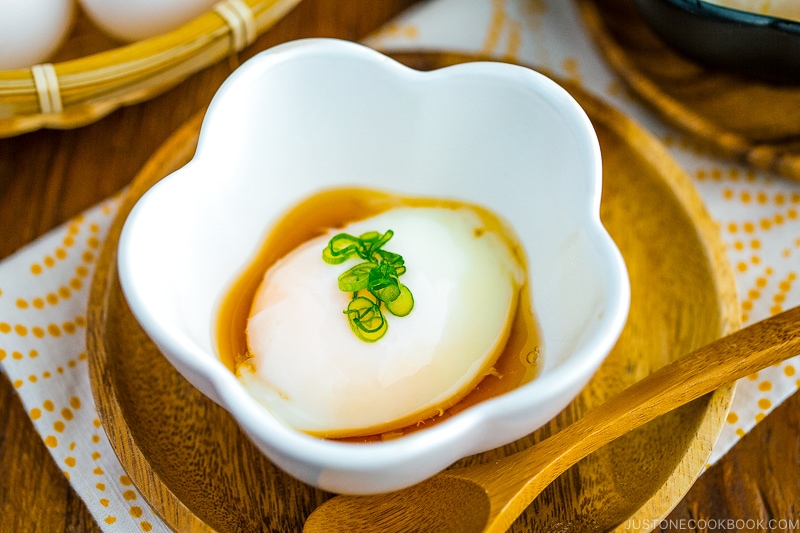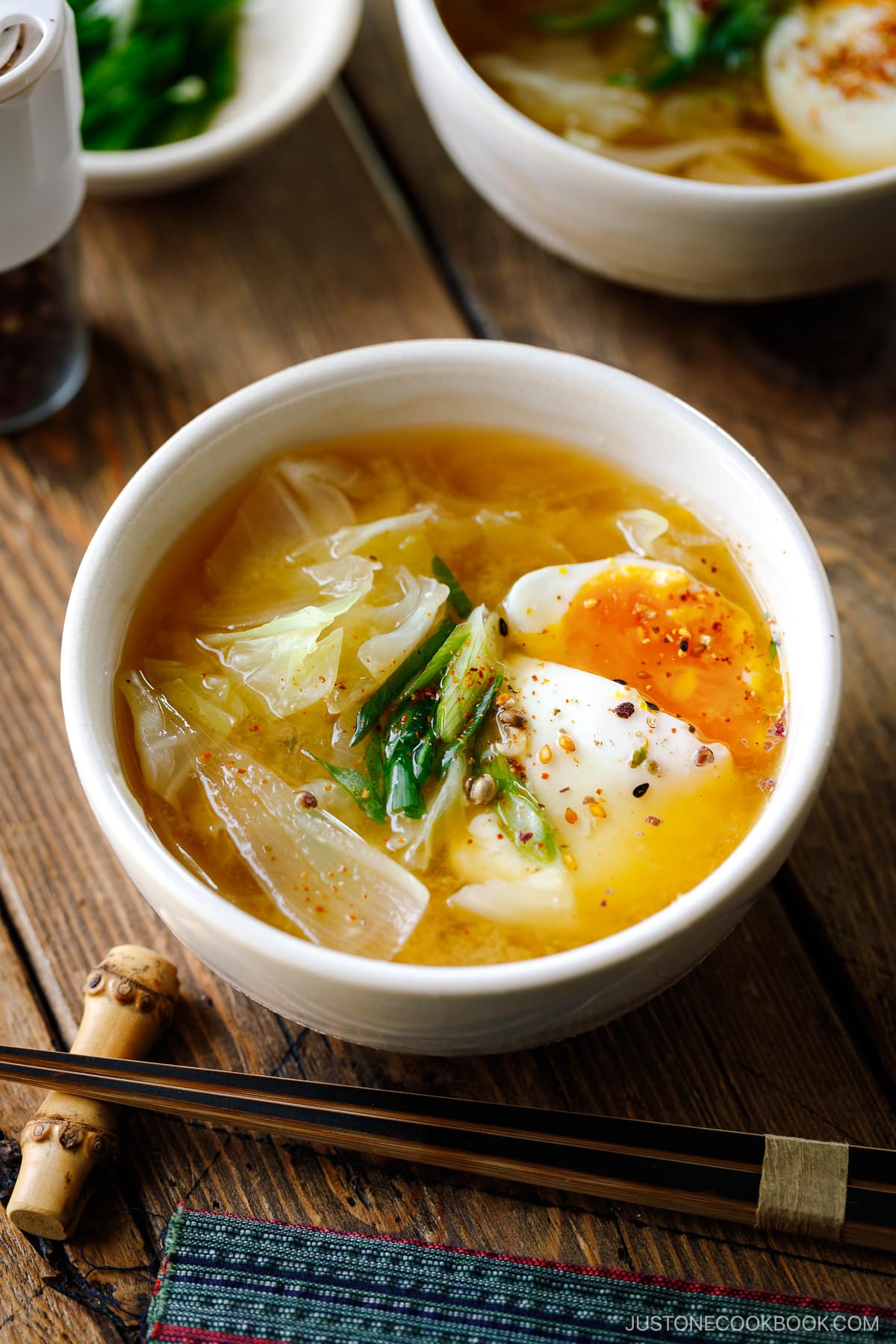This Cabbage and Onsen Tamago Miso Soup is a hearty and flavorful soup you can easily make in 15 minutes or less! We’ll use the microwave to make the silky poached egg (onsen tamago) and speed things up, but the result is just as satisfying.


Have chilly spring days? Need a quick soup lunch? This Cabbage and Onsen Tamago Miso Soup is perfect for warmth and coziness.
The broth is savory, filled with tender strands of sweet cabbage and anchored by a ‘hot spring’ egg that oozes creaminess, melding beautifully into the soup when you break it open. Certainly not quite the same as the classic miso soup you’re familiar with but more satisfying.
Hearty yet light, flavorful yet simple, warming yet uplifting—this soup has everything I crave. I’m sure it will also have the same effect on you, so make it soon!
Why You’ll Love This Recipe
- It requires only pantry or refrigerator staples, and it’s a delicious soup to make when you have leftover cabbage.
- With protein and a good dose of vegetables, this soup is a fabulous standalone quick lunch or a simple dish to pair with rice.
- Just 15 minutes is all you need.
What is Onsen Tamago?


Onsen refers to hot spring, while tamago means eggs, so onsen tamago translates to ‘hot spring eggs’ in Japanese. Fancy as it sounds, it’s a poaching technique to create silky egg whites and custard-like yolks.
The typical method is to poach the egg in hot water (see and read my original recipe), but today I’ll show how to make onsen tamago in the microwave! Yes, you might call this cheating, but the result is still excellent, and it certainly saves a lot of time on busy days. You can make onsen tamago in less than 2 minutes!


Ingredients You’ll Need
How to Make Cabbage and Onsen Tamago Miso Soup
Detailed instructions can be found in the recipe card below. Here’s a quick summary.
Jump to Recipe
- Add water, sliced onion, and dashi packet in a medium saucepan. Cover and bring to a boil.
- Reduce the heat to medium-low and cook, covered, for 4–5 minutes. Then discard the dashi packets.
- Add the cabbage and cook, covered, until the onion and cabbage are tender, about 4–5 minutes.
- Turn off the heat and stir in the miso paste until dissolved. Taste and adjust.
- Make onsen tamago in the microwave. Transfer the poached egg to the miso soup.
- Garnish the soup with chopped green onions. Sprinkle shichimi togarashi (Japanese seven spice) and Japanese sansho pepper, if you like a spicy, peppery kick.


Recipe Tips
This is such an easy recipe, but here are some key points to remember when cooking it.
- Make dashi using a dashi packet or make it from scratch. I always recommend avoiding dashi powder, especially when making miso soup, because the flavor is much weaker than dashi made with a packet or from scratch.
- Cut the onions and cabbage into uniform pieces. This way, the ingredients will finish cooking simultaneously, not like some pieces are more undercooked than others.
- Add miso paste right before serving to enjoy its best flavor and aroma!
- Adjust the microwave time and power to cook onsen tamago to your liking. The shape of a microwave-safe bowl matters. The recipe card provides more details.
How to Store
Generally, it‘s best to consume all the miso soup immediately because it will lose its aroma and taste as time passes. If you like keeping the leftovers, let your miso soup cool to room temperature and refrigerate. You can keep it in the refrigerator for up to 2 days or in the freezer for 2 weeks. However, if you add tofu to our miso soup, remove it before freezing, as the texture will change.
If you want to make a big batch to store for later, it‘s best to refrigerate the soup without adding the miso. When ready to use, add the miso paste only for the portion you need.
What to Serve with This Hearty Miso Soup
As I mentioned, it makes a great lunch soup to accompany a simple bowl of rice or fried rice. I like to add a side of natto to amp up the nutrients. You can also serve the soup as part of your dinner, especially in an ichiju sansai (one soup, three dishes) format.
Let’s Cook Miso Soup for Miso Day


In January 2024, I started sharing a new miso soup recipe on the 30th of every month to encourage and inspire readers like you to enjoy the soup as part of your diet. The idea came about because the 30th day (三十日) is read as misoka (みそか) in Japanese, which initiated Miso Day (味噌の日).
You have probably heard about the health benefits of miso soup, and I’m glad you are here to learn more about this staple of Japanese cuisine.
There are many ways to prepare it, so check out my collection of miso soup recipes!


Wish to learn more about Japanese cooking? Sign up for our free newsletter to receive cooking tips & recipe updates! And stay in touch with me on Facebook, Pinterest, YouTube, and Instagram.


Cabbage and Onsen Tamago Miso Soup
This Cabbage and Onsen Tamago Miso Soup is a hearty and flavorful soup you can easily make in 15 minutes or less! I will show you how to make an Onsen Tamago in the microwave in this recipe.
Ingredients
Prevent your screen from going dark
Instructions
-
Gather all the ingredients.
-
Remove the core of ¼ onion and cut into thin slices.
-
In a medium saucepan, add 3 cups water, sliced onion, and 2 dashi packets. Cover the saucepan with a lid and bring it to a boil on medium heat.
-
Remove the core of ⅛ green cabbage and cut into small pieces, about ¾ inch (2 cm) squares. If you see tough, dense pieces, discard them or use them for other recipes. Alternatively, you can add to the saucepan earlier than leafy parts).
-
Cut 1 green onion/scallion in half widthwise and diagonally cut into thin slices.
-
Once the dashi is boiling, shake the dashi packets to release more flavor. Reduce the heat to medium-low and cook, covered, for 4–5 minutes. Then, discard the dashi packets.
-
Add the cabbage and cook, covered, until both the onion and cabbage are tender, about 4-5 minutes.
-
While cooking the onion and cabbage, prepare onsen tamago. Crack each of 3 large eggs (50 g each w/o shell) in a small microwave-safe bowl. You can cook one egg at a time. Find a bowl similar to a rice bowl shape (The bowl’s opening should be straight up from the bottom of the bowl). Then, pour the water around the edges of the bowl, pushing the egg to the center.
-
Then, pour the remaining water on top of the egg yolk, covering it completely.
-
Place the bowl at the edge of the microwave tray. Microwave (500W—I use half power or P5) for 90 seconds, or until the egg white JUST solidified and turned white. The egg yolk should be pinkish and runny at this stage since it takes longer to solidify than the egg white. DO NOT OVERCOOK. If your egg white is still transparent, microwave for 5 seconds more and check.
-
Immediately scoop the onsen tamago out with a slotted spoon and drain the cooking water. Don’t keep the egg in the cooking water as the remaining heat will continue to cook. Repeat the same process for the next egg.
-
When the cabbage is tender, turn off the heat and add 3 Tbsp miso. Taste the soup and add more miso if needed. If it‘s too salty, add water or dashi (if you have any) to dilute.
To Serve
-
Serve the miso soup in individual bowls, place the onsen tamago on top, and garnish with chopped green onions. Sprinkle shichimi togarashi (Japanese seven spice) and Japanese sansho pepper, if you enjoy a bit of a spicy kick.

